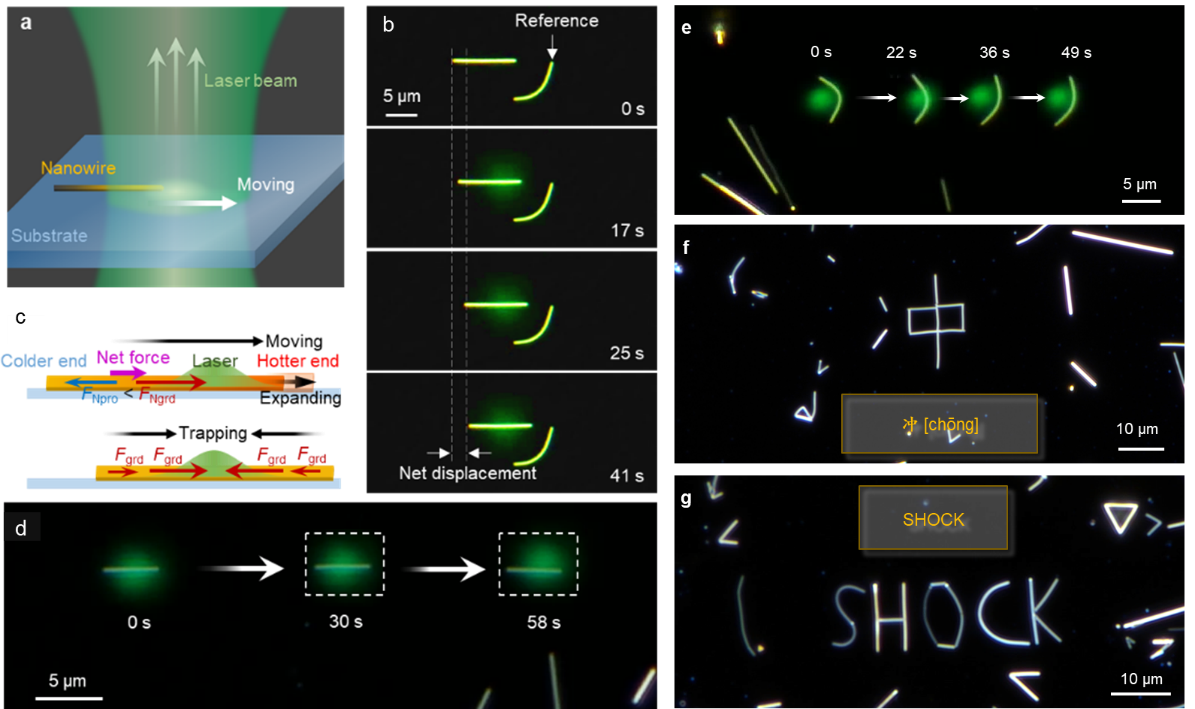Recently, under the academic guidance of Academician Zhuang Songlin from the School of Optical-Eletrical and Computer Engineering, Professor Gu Fuxing,together with his research partners, invented a laser trapping technology based on photothermal shock effect, called Photothermal Shock Tweezers. This technology enables the trapping and arbitrary manipulation of micro and nano objects on solid interfaces, and affords the possibility to explore its application in nanorobots. on November 24th,The related achievement "Autonomous nanorobots with powerful thrust under dry solid contact conditions by photothermal shock" was published in Nature Communications. The team members, Ph.D candidates Gu Zhaoqi, Zhu Runlin, and Shen Tianci, are the first co-authors, Professor Gu Fuxing is the corresponding author, and collaborators are also from other universities including Professor Liu Xu from Hebei University of Technology and Professor Liu Jia from Auburn University in the United States. Academician Zhuang Songlin offered full guidance throughout the study. The research has received funding from the National and Shanghai Natural Science Foundation. This technology is expected to explore unprecedented applications in various fields such as nanomanufacturing, biomedical, aerospace, and military.

The Photothermal Shock Tweezers system can seamlessly inherit robot technology from the macro world and achieve intelligent robot work scenarios in the micro world. The team utilized a metal nanosheet, combined with technologies such as image recognition, deep learning, path planning, and feedback control, to achieve the world's first autonomous nanorobot with cleaning capabilities. By identifying the cleanliness level of the selected area, the robot will repeat the cleaning cycle until satisfactory cleanliness is achieved.

It is understood that laser trapping is a powerful tool for manipulating the motion of objects in the nano world. Researchers were awarded the Nobel Prize in Physics in 1997 and 2018 for their achievements in put laser trapping into widespread application in suspended media environments such as vacuum and liquid. However, it still presents challenges on solid contact surfaces. Researchers use a pulse light source to heat micro nano objects, and the absorbed light pulse energy is instantly converted into mechanical expansion, generating a huge instantaneous load inside the object, known as photothermal shock. The force generated by this instantaneous impact effect far exceeds that of ordinary vibration modes, thus breaking the micro nano resistance dilemma and achieving movement on solid interfaces.


The trapping is the core of laser manipulation technology, as it can trap the movement of particles through the position of the spot, achieving arbitrary motion control. Under the action of a Gaussian beam with a 532nm nanosecond pulse, nanowires will move towards the interior of the beam until the center of the nanowire aligns with the center of the beam, which is a typical trapping process. Researchers have identified the physical source of the driving force of photothermal shock through theoretical analysis. As the expression includes a temperature gradient, this force is called the photothermal gradient force. When the light spot is moved, the balance of the photothermal gradient force distribution is disrupted, and the nanowires move back towards the center of the light spot, repeating this process. The nanowires will continue to move axially with the light spot. In addition, for the nanowires trapped in the center of the spot, increasing the laser power will cause the two ends of the nanowires to be subjected to greater photothermal gradient forces and bend laterally, thereby achieving lateral movement. This enables the arbitrary movement of nanowires on a two-dimensional plane. The following figure shows the research team's pattern of combining multiple nanowires into the Chinese character "冲" and the English word "SHOCK".
Researchers have also used palladium nanosheets as a chassis to build a more complex and versatile nanorobot, known as the HOUbot due to its resemblance to the Chinese horseshoe crab (Figure 4a and video). This robot can move freely like a car and perform higher degrees of freedom and finer movements such as head pushing, independent tail swinging, and stabbing. The robot is equipped with semiconductor nanowires that can be used for in-situ humidity sensing. Due to its relatively large surface, the robot has strong load capacity, with a theoretical payload of up to milligrams (equivalent to the mass of an ant). By adopting existing macroscopic mechanical designs to equip more airborne components or cargo, HOUbots can work like macroscopic robots and are the world's first nanorobots that can perform specific tasks using traditional mechanical means.
The invention of photothermal tweezers technology has enabled laser manipulation to break through the interface resistance dilemma, filling the application environment of optical manipulation, and ultimately enabling laser to manipulate objects in micro and nano environments comparable to the three boundaries of sea, land, and air (vacuum/gas, liquid, and solid). In physics, the focus is on transient thermoelastic dynamics and tribology, especially non-destructive research, which further reveals the understanding of mechanical dynamic processes in the microscopic field. This technology can be used in principle for any wavelength range and any absorbable material. In addition, through spatial light modulation and multi robot collaboration, autonomous nanorobot clusters can be achieved, completing complex tasks that cannot be achieved by conventional methods.
After the publication of this achievement, multiple professional websites have followed and commented on it. Foreign professional websites such as AZOAI have published a review article by Dr. Silpaja Chandrasekar, highly praising the achievement::Rresearchers introduced a game-changing solution to nanorobotic motion limitations on solid surfaces.Overall, this groundbreaking technique demonstrated its adaptability by manipulating various nanomaterials. Domestic media such as Guokr and MIT Technology Review China/DeepTech have also conducted relevant interviews.
Related:https://www.nature.com/articles/s41467-023-43433-6
https://www.azoai.com/news/20231129/Autonomous-Nanorobots-Achieve-Powerful-Thrust-on-Dry-Surfaces-Using-Photothermal-Shock.aspx

 Home
·
News & Events
·
Content
Home
·
News & Events
·
Content

